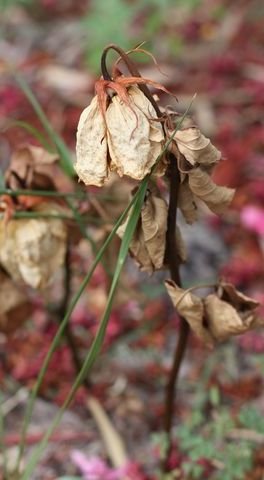Post Emergent Weed Control
|
Post emergent weed control is The other is pre-emergent. |

|
These are herbicides that are applied to weeds growing above soil.
The Action process falls under two categories - Systemic and Contact. They are applied directly on the weed breaking down it's tissue. There are both Selective and Non Selective Herbicide.
This page details Selective Herbicides.
Systemic
Systemic herbicides work by the chemicals first being sprayed on the weed. The weed absorbs chemicals and is transported throughout the tissue, roots and all.
These chemicals attack only the weed that they are placed on and not threatening any surrounding vegetation.
The process is not instant. Depending on the chemical used, it can take hours up to a week for the weed to break down. It can be effective on both annual and established perennial weeds. This systemic process uses selective herbicides.
a) Selective Herbicides
(usually non-residual)
- Selective herbicides kill specific types of weeds. This works by sourcing the different hormones found in each weed group type.
When the chemicals are applied they block the weed's hormones. This will then control, or inhibit normal growth, ultimately killing the weed.
Because these chemicals are limited to specific weeds they are also Non-Residual. Non-Residual means that the chemicals don't percolate beyond the weed keeping surrounding soil healthy rather than sterilizing it. Residual are under the non-selective herbicide page.
The weed group types that selective herbicides target
are Dicots, Monocots and Sedges.
Dicots and broadleaf plants emerge from two major groups of angiosperms. An angiosperm is a seed producing plant. 'Di' means two, forms two leaves when emerging from the seed. These are more often termed Broadleaf Weeds.
A dicot tends to be oval shaped and flat. Leaf veins branch out and have one long central tap-root that travels deep into the ground.
Examples of Broadleaf weeds are:
- Common Chickweed
- Knotweed
Perennials
- Clover
- Creeping Buttercup
- Ground Ivy
- Creeping Thistle
- Dandelions
- Common Plantain
Monocots are weeds that emerge from the seed having one leaf, 'mono' meaning one. They are produced one at a time and can be lawn grasses and grassy weeds (Poaceae family/formerly known as Gramineae). Monocots are both annual and perennial weeds.
A monocot has short fibrous roots that are closer to the soil's surface. Leaves usually are long and narrow having a blade-like appearance with veins that run parallel.
Examples of these weeds are:
- Barnyard Grass
- Annual Bluegrass
- Cheatgrass
- Crab Grass
- Downy Brome
- Fox Tail
- Goose Grass
- Tall Fescue
Perennials
- Dallis Grass
- Knotgrass
- Johnson Grass
3) Sedges
Sedges are different weedy grasses than Monocots.
Sedge grass stems feel round or triangular and have three rows of leaves growing out from them. Their leaves are solid and jointless and the flowers at the top are spike-like in appearance.
Sedges also like to grow in soils that are rich with moisture.
Examples of Sedge weeds include:
- Beak Rush
- Kyllinga
- Purple Nutsedge
- Texas Nutsedge
- Star of Bethlehem
- Yellow Nutsedge
- Wild Onion
If you are unsure of which type of grass you are dealing with here's one big tip... a disappointing tip, but still a tip:
Herbicides used for the Monocot grasses will
NOT be effective on Sedges.
Depending on the sedge grass, they are not always considered a weed. Many times they look beautiful in your garden used as an ornamental grass.
Even with the use of selective herbicides it should be noted that this method of post emergent weed control has drawbacks...
Many times these targeted weeds can grow back larger and more challenging. It is recommended that you rotate different chemicals rather than using the same one over and over again. Please note, however, soils lose important microbes while weeds are becoming more resistant to these chemicals.
Also, it has been proven that post emergent weed control is reducing pollinator numbers because of the chemicals (especially glyphosate) used in these over the counter products.
Related Articles:
Soil Testing Methods -
Soil also matters when it comes to control - both
pre-emergent and Post emergent weed control.
Back from Post Emergent Weed Control to How to Kill Weeds
Site Map: Butterfly Website
Back from Post Eemergent to Easy Butterfly Garden.com
 Copyright © 2010-2022 Easy-Butterfly-Garden.com
Copyright © 2010-2022 Easy-Butterfly-Garden.com
Privacy Policy Disclaimer

Join Easy Butterfly Garden on Facebook
Recent Articles
-
Annual Bluegrass
Jan 14, 17 08:14 PM
Annual bluegrass (Poa annua) is considered a weed in the Poa family, which has a few popular turf grasses. If this gets into your butterfly garden listed are a few ways to eradicate it.
-
Candytuft Flowers
Sep 25, 16 10:54 PM
There are the annual, or Iberis, candytuft flowers and also perennials which are called Iberis sempervirens.
-
Keeping Deer Out
Sep 19, 16 01:10 PM
Reviewing the types of products available for keeping deer out of our gardens along with building fences. Many of these products help with other garden pests.
-
Butterfly Meadows
Sep 19, 16 12:52 PM
Compared to other wildlife gardening, butterfly meadows take time and are not for the faint of heart.
-
Natural Gardening
Sep 19, 16 12:32 PM
Natural gardening includes different types of gardens. These garden types create a casual, natural envirionment and help sustain native wildlife which includes butterflies.






New! Comments
Have your say about what you just read! Leave me a comment in the box below.